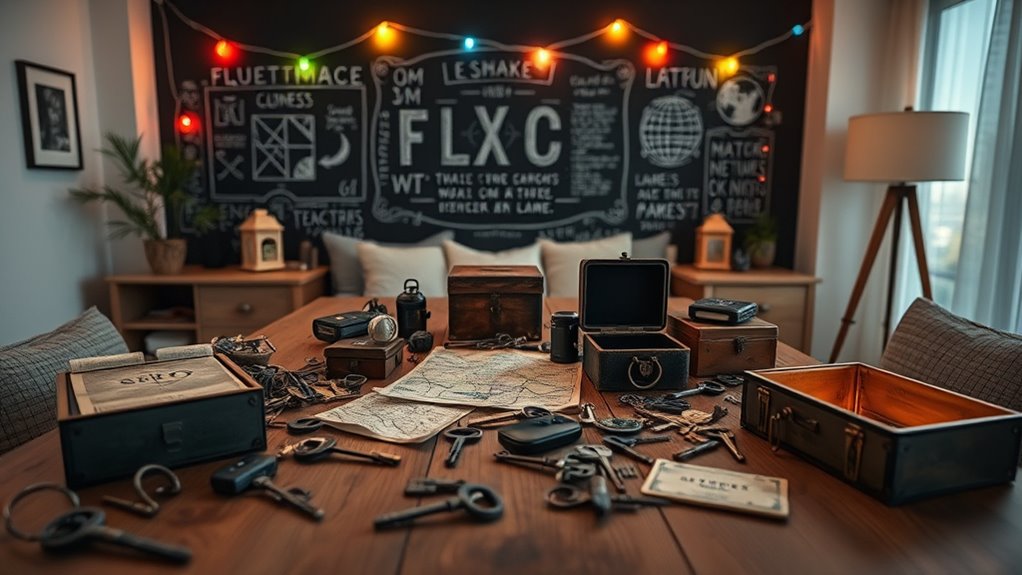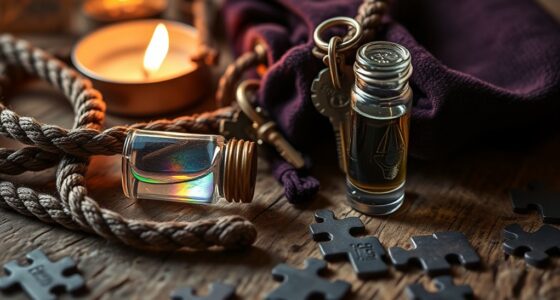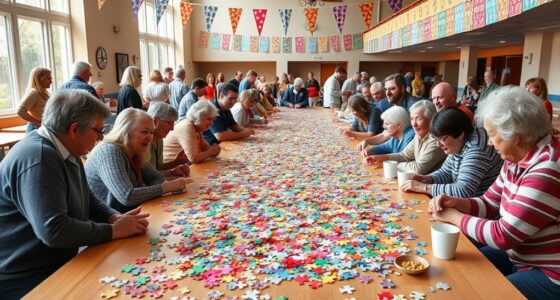To design your own puzzle escape room at home, start by picking a engaging theme like pirates or mystery, then create themed clues and puzzles that blend seamlessly with your décor. Plan different stations or rooms to build excitement and guide participants naturally through the story. Use interactive elements like hidden compartments and cipher puzzles, and set a satisfying final reveal. If you want to learn how to craft a memorable experience, there’s more to explore ahead.
Key Takeaways
- Choose a captivating theme and decorate accordingly to create an immersive atmosphere.
- Design interconnected puzzles and clues integrated seamlessly into the theme for natural engagement.
- Plan a space layout with multiple stations or rooms to guide players through progressive challenges.
- Craft a rewarding final reveal that ties all clues together and enhances the storyline.
- Test puzzles in advance, balance difficulty, and prepare the setup for smooth gameplay.

Creating a puzzle escape room at home is a fun and engaging way to challenge your problem-solving skills and entertain friends or family. The first step is to choose a compelling theme that sets the tone for the entire experience. Whether it’s a spy mission, a haunted mansion, or a pirate treasure hunt, your theme will guide your decorations and puzzles. To immerse players fully, incorporate themed decorations that reflect your chosen setting. Think of vintage maps, spooky props, or nautical artifacts—anything that transports players into the story. These themed decorations not only enhance the atmosphere but also serve as visual clues or conversation starters, making the game more immersive.
Design your home escape room with a captivating theme and immersive decorations to enhance the experience.
Next, focus on designing interactive clues that players can manipulate or decipher. These clues should be integrated seamlessly into your theme, encouraging participants to engage actively with their environment. For example, hide a secret message behind a puzzle box or embed a code in a piece of artwork. Use objects that fit naturally into your decor, so clues don’t feel out of place. Interactive clues can include cipher wheels, jigsaw puzzles, or hidden compartments in furniture. The key is to make each clue meaningful and connected to the storyline, so players feel like they’re unraveling a story rather than just solving disconnected puzzles. Remember, clues should vary in difficulty to keep the game challenging but not frustrating.
As you craft your puzzles, consider the layout of your space. Create different stations or rooms if possible, each revealing new clues or tasks that lead toward the final goal. Keep in mind that a well-paced sequence will sustain excitement. Incorporate visual and tactile elements to make clues more engaging. For example, a puzzle might require players to arrange objects in a certain order, or decode a message using a cipher. Test your puzzles beforehand to guarantee they’re solvable and balanced in difficulty, adjusting as needed. This preparation will prevent frustration and keep the game flowing smoothly. Additionally, utilizing natural materials like wood or linen can add authenticity and texture to your setup.
Finally, plan your final reveal or escape moment. It could be unveil a treasure chest, opening a secret door, or revealing a hidden message. Make sure the culmination feels rewarding, tying together all the clues and themes you’ve set up. By paying attention to thematic decorations and designing interactive clues that complement your storyline, you’ll create an unforgettable home escape room experience that challenges and entertains everyone involved.
Frequently Asked Questions
What Are the Best Themes for a Home Escape Room?
You should choose themes that spark excitement and creativity, like a detective mystery or a jungle adventure. Use themed decorations to immerse players and enhance the story narrative. Consider popular themes like pirates, space exploration, or secret agents, as they inspire engaging puzzles and decor. The right theme makes the experience memorable, encouraging teamwork and problem-solving while making the escape room feel authentic and fun.
How Many Players Are Ideal for a Home Escape Game?
Ever wondered what team size works best for your home escape game? Generally, 3 to 6 players is ideal, as it balances team dynamics and keeps everyone engaged. Too many players can lead to chaos, while too few might slow the progress. Do you want your game to be fast-paced or more collaborative? Adjust the team size accordingly, ensuring everyone participates and has fun solving puzzles together.
What Safety Precautions Should I Consider?
You should prioritize safety by make certain all players have access to safety equipment like fire extinguishers and first aid kits. Clearly mark emergency exits and keep pathways unobstructed to facilitate quick evacuation if needed. Regularly inspect your setup for hazards, and inform players about safety procedures before starting. These precautions help prevent accidents and ensure everyone enjoys the game safely.
How Long Should the Escape Room Last?
You should aim for an escape room lasting about 60 minutes, balancing challenge and fun. For example, a family game with moderate difficulty might take 45-60 minutes, keeping players engaged without fatigue. Set a time limit that matches your difficulty level—too long can cause boredom, too short may be frustrating. Adapt based on your group’s age and experience to guarantee everyone stays excited and challenged throughout.
Can I Include Digital or Electronic Puzzles?
Yes, you can definitely include digital puzzles and electronic lock integration in your escape room. Digital puzzles add a modern touch and challenge players with tech-based riddles, while electronic locks make solving clues more interactive. You can incorporate QR codes, online puzzles, or app-based challenges, making your game more dynamic. Just guarantee these elements fit seamlessly into your storyline and are user-friendly to keep everyone engaged and excited.
Conclusion
Creating your own puzzle escape room at home is a fun, rewarding experience. With some creativity and planning, you can turn any space into an exciting challenge for friends and family. Did you know that 65% of escape room players say they enjoy puzzles more when they’re personalized? So, tailor your clues and themes to make it even more memorable. Get ready to challenge, surprise, and have a blast with your custom escape room!








